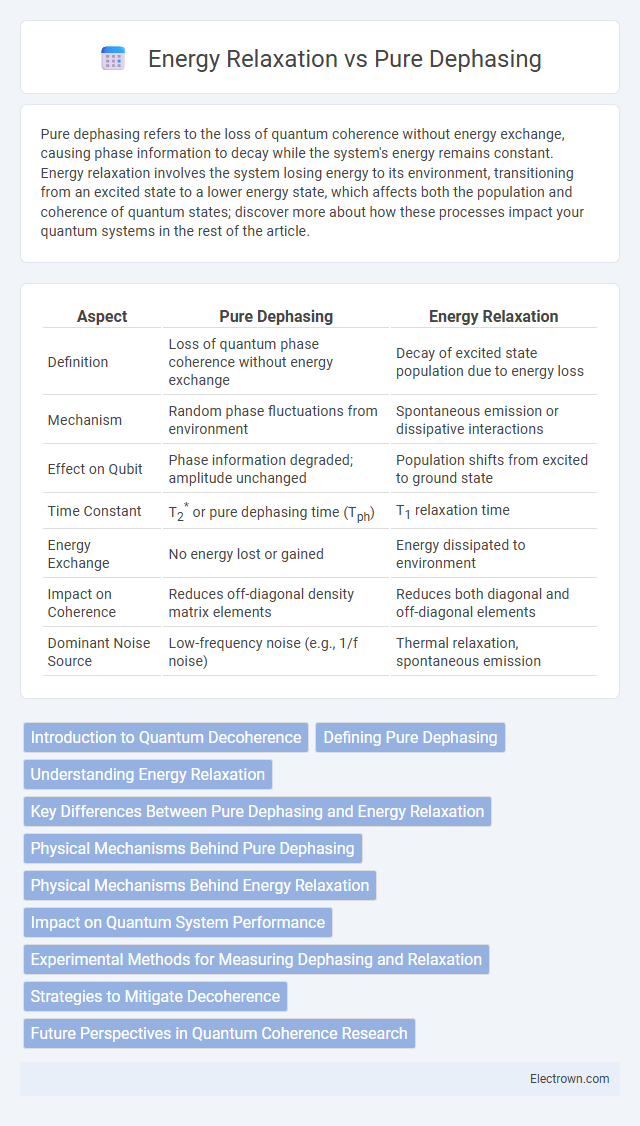Pure dephasing refers to the loss of quantum coherence without energy exchange, causing phase information to decay while the system's energy remains constant. Energy relaxation involves the system losing energy to its environment, transitioning from an excited state to a lower energy state, which affects both the population and coherence of quantum states; discover more about how these processes impact your quantum systems in the rest of the article.
Table of Comparison
| Aspect | Pure Dephasing | Energy Relaxation |
|---|---|---|
| Definition | Loss of quantum phase coherence without energy exchange | Decay of excited state population due to energy loss |
| Mechanism | Random phase fluctuations from environment | Spontaneous emission or dissipative interactions |
| Effect on Qubit | Phase information degraded; amplitude unchanged | Population shifts from excited to ground state |
| Time Constant | T2* or pure dephasing time (Tph) | T1 relaxation time |
| Energy Exchange | No energy lost or gained | Energy dissipated to environment |
| Impact on Coherence | Reduces off-diagonal density matrix elements | Reduces both diagonal and off-diagonal elements |
| Dominant Noise Source | Low-frequency noise (e.g., 1/f noise) | Thermal relaxation, spontaneous emission |
Introduction to Quantum Decoherence
Quantum decoherence arises from interactions between a quantum system and its environment, leading to the loss of coherent superpositions. Pure dephasing specifically refers to the decay of off-diagonal elements of the density matrix without energy exchange, causing phase information loss while preserving population states. In contrast, energy relaxation involves the exchange of energy between the system and environment, driving the system towards thermal equilibrium and altering population distributions.
Defining Pure Dephasing
Pure dephasing refers to the loss of quantum coherence without energy exchange between the system and its environment, characterized by fluctuations in the phase of the quantum state. Energy relaxation involves the system dissipating energy to the environment, leading to a change in population of energy levels. Understanding pure dephasing is crucial for improving coherence times in quantum computing and other quantum technologies where preserving phase information, rather than just energy states, is vital.
Understanding Energy Relaxation
Energy relaxation refers to the process by which an excited quantum system loses energy to its surrounding environment, returning to a lower energy state over time. This phenomenon directly impacts the coherence time of quantum states by causing the system's population to decay, contrasting with pure dephasing that only affects phase coherence without energy loss. Understanding energy relaxation is crucial for optimizing quantum device performance, as minimizing it helps maintain your system's overall fidelity and operational stability.
Key Differences Between Pure Dephasing and Energy Relaxation
Pure dephasing refers to the loss of quantum coherence without energy exchange, characterized by the decay of off-diagonal density matrix elements, whereas energy relaxation involves the system returning to thermal equilibrium by exchanging energy with its environment, impacting the diagonal elements. Pure dephasing time (T2*) is typically shorter than energy relaxation time (T1), with T1 governing the population decay and T2* governing phase coherence loss. This fundamental difference affects quantum computing qubit performance, where minimizing pure dephasing preserves coherence without altering energy states, while managing energy relaxation controls qubit lifetime.
Physical Mechanisms Behind Pure Dephasing
Pure dephasing arises primarily from interactions with low-frequency fluctuations in the environment, such as spectral diffusion caused by fluctuating charges or nuclear spins. These disturbances lead to random phase shifts in your quantum system's coherence without energy exchange, distinguishing pure dephasing from energy relaxation processes that involve population decay. The microscopic origin of pure dephasing often involves phonon interactions or spin noise, which scramble phase information while leaving energy levels unchanged.
Physical Mechanisms Behind Energy Relaxation
Energy relaxation primarily occurs through interactions between a quantum system and its surrounding environment, leading to the exchange of energy with phonons, photons, or other excitations. This process drives the system toward thermal equilibrium by dissipating excess energy and causing population decay from excited to lower energy states. Unlike pure dephasing, energy relaxation involves actual energy loss and is characterized by changes in the population of energy levels rather than just the loss of coherence.
Impact on Quantum System Performance
Pure dephasing primarily affects the coherence of quantum states by causing phase randomization without energy loss, leading to reduced quantum interference and gate fidelity in your quantum system. Energy relaxation involves the loss of energy from excited states to lower energy states, resulting in population decay that limits the system's operational time and qubit lifetime. Both processes degrade quantum system performance by reducing coherence times, but pure dephasing dominates phase errors while energy relaxation contributes to amplitude damping.
Experimental Methods for Measuring Dephasing and Relaxation
Experimental methods for measuring pure dephasing and energy relaxation primarily involve techniques like Ramsey fringes and spin echo for dephasing, and energy relaxation time (T1) measurements using time-resolved spectroscopy. Ramsey fringes detect coherence decay by monitoring phase evolution, while spin echo sequences mitigate inhomogeneous broadening effects to isolate pure dephasing. Energy relaxation is quantified by measuring the decay of excited state populations over time, providing insight into interactions causing energy dissipation in quantum systems.
Strategies to Mitigate Decoherence
Mitigating decoherence involves tailored strategies for pure dephasing and energy relaxation, such as dynamical decoupling to counteract environmental noise causing phase errors, and quantum error correction codes designed to protect against energy dissipation. Implementing low-temperature environments and material engineering helps reduce phonon interactions that contribute to both dephasing and relaxation processes. Your quantum system's coherence time can be significantly enhanced by combining these approaches with optimized qubit control and isolation techniques.
Future Perspectives in Quantum Coherence Research
Future perspectives in quantum coherence research emphasize minimizing pure dephasing to extend qubit coherence times critical for scalable quantum computing. Energy relaxation rates remain a primary limitation, driving innovations in material engineering and noise suppression techniques to enhance quantum state stability. Optimizing your quantum devices by balancing pure dephasing and energy relaxation control will unlock higher-fidelity operations essential for next-generation quantum technologies.
pure dephasing vs energy relaxation Infographic

 electrown.com
electrown.com